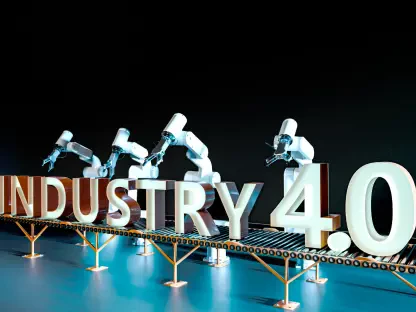In a world where artificial intelligence is reshaping industries at an unprecedented pace, the infrastructure supporting these technologies must evolve just as rapidly to keep up with soaring computational demands. At the OCP Global Summit held in San Jose, California, Meta emerged as a trailblazer, unveiling transformative networking solutions designed specifically for AI workloads. As a founding member of the Open Compute Project (OCP) since its inception, Meta has consistently driven innovation, and this year’s event marked a significant leap forward. Their focus on scalable, efficient, and open-standard systems addresses the critical challenges of modern data centers and sprawling AI clusters. This article explores the groundbreaking strides Meta is making in AI networking, diving into their visionary strategies, cutting-edge technologies, and collaborative efforts that promise to redefine the landscape of data infrastructure for years to come.
Redefining AI Infrastructure with Visionary Strategies
Meta’s approach to AI infrastructure, as showcased at the OCP Global Summit, underscores a fundamental shift in how data centers must be designed to handle the complexities of AI applications. The company recognizes that traditional architectures are insufficient for the massive scale and speed required by today’s AI models. Leaders like Vice President Yee Jiun Song and Software Engineer Kaushik Veeraraghavan emphasized the need for innovation across every layer of the technology stack. From hardware components to overarching network designs, Meta is crafting solutions that prioritize adaptability and power. Their mission is to build systems capable of supporting not just current demands but also the exponential growth expected over the coming years, ensuring that AI can continue to drive progress without being hindered by outdated infrastructure limitations.
A cornerstone of Meta’s strategy lies in its unwavering commitment to open systems and standards, which are vital for fostering interoperability in an increasingly diverse tech ecosystem. By promoting standardized racks, power solutions, and network architectures, Meta ensures that a wide array of hardware, such as GPUs and accelerators, can integrate seamlessly into their frameworks. This dedication to openness reduces the friction often caused by proprietary systems, enabling faster deployment and greater flexibility. Through strategic partnerships and initiatives, Meta is laying the groundwork for an industry-wide shift toward collaborative innovation, positioning itself as a leader in creating infrastructure that can scale effortlessly alongside AI’s rapid advancements.
Pioneering Networking Fabrics for AI Demands
Among the most striking innovations presented by Meta at the summit are their advanced networking architectures, tailored specifically to meet the diverse needs of AI workloads. The evolved Disaggregated Scheduled Fabric (DSF) stands out as a two-stage system capable of supporting non-blocking interconnects for up to 18,432 processing units. Utilizing Ethernet-based protocols like RoCE/RDMA, DSF connects endpoints and accelerators from multiple vendors with remarkable efficiency. Its use of Virtual Output Queuing for traffic scheduling proactively mitigates congestion, making it ideal for large, modular AI clusters. This architecture reflects Meta’s focus on scalability, ensuring that even the most computationally intensive tasks can be managed without bottlenecks or performance lags.
Complementing DSF is the Non-Scheduled Fabric (NSF), a three-tier design built on shallow-buffer Ethernet switches to achieve ultra-low latency, a critical factor for high-performance AI environments. NSF incorporates adaptive routing for optimal load balancing, enhancing GPU utilization in massive clusters like the gigawatt-scale Prometheus, often referred to as an “AI factory.” Unlike DSF, which excels in modular scalability, NSF is engineered for extreme performance, catering to workloads where speed is paramount. This dual-fabric approach demonstrates Meta’s nuanced understanding of AI infrastructure challenges, offering tailored solutions that address specific operational needs while maintaining flexibility to scale across geographic regions and varying data center setups.
Transforming Connectivity with Optical Innovations
Meta’s advancements in optical networking, revealed at the OCP Global Summit, further solidify their role as an innovator in AI infrastructure. Building on previous successes, the company has deployed solutions like the 2x400G FR4 BASE optics for longer 3-kilometer links, and this year introduced the cost-optimized 2x400G FR4 LITE, designed for shorter 500-meter intra-data center connections. These developments prioritize both performance and affordability, addressing the practical constraints of modern data centers where shorter-range connectivity is often the norm. By focusing on cost-effective high-speed solutions, Meta ensures that organizations can build robust networks without prohibitive expenses, making advanced AI infrastructure more accessible across the industry.
In addition to FR4 LITE, Meta unveiled new 400G DR4 optics, including OSFP-RHS and 2x400G DR4 OSFP variants, which enhance host-to-switch connectivity for their 51Tbps platforms. These optical innovations are pivotal for supporting the intense data transfer rates required by AI workloads, ensuring minimal latency and maximum throughput. The balance struck between cutting-edge technology and economic viability highlights Meta’s pragmatic approach to infrastructure challenges. By refining optical connectivity, Meta not only boosts the efficiency of current data center operations but also lays a foundation for future expansions, where high-performance networking will be even more critical to sustaining AI growth.
Fostering Industry-Wide Progress Through Collaboration
Meta’s leadership in collaborative initiatives, particularly through the Ethernet for Scale-Up Networking (ESUN) program, marks a significant step toward unifying the industry around open standards for AI networking. Partnering with major players like NVIDIA, AMD, and Microsoft, Meta is driving the standardization of Ethernet-based scale-up solutions, explicitly moving away from proprietary technologies that can stifle scalability and increase costs. This collaborative effort focuses on ensuring interoperability of processing unit interfaces and switch ASICs, allowing for seamless integration of the latest hardware innovations. Such partnerships are essential for creating an ecosystem where AI infrastructure can evolve without being constrained by vendor-specific limitations.
Alignment with broader industry groups, such as the Ultra-Ethernet Consortium (UEC) and IEEE 802.3 Ethernet standards, further amplifies Meta’s impact on AI networking. By contributing to these collective efforts, Meta helps shape a future where open standards accelerate innovation and reduce barriers to adoption. This focus on collaboration ensures that advancements in AI infrastructure benefit not just individual companies but the entire tech landscape. The push for standardized, interoperable systems reflects a growing consensus that scalability and cost-effectiveness are best achieved through shared goals, positioning Meta as a catalyst for industry-wide transformation in how AI networks are built and deployed.
Reflecting on a Legacy of Innovation
Looking back at Meta’s showcase at the OCP Global Summit, it’s evident that their contributions marked a defining moment in the evolution of AI networking. Their development of scalable architectures like DSF and NSF addressed critical needs for modularity and low-latency performance, while optical innovations such as FR4 LITE and DR4 optics provided cost-effective, high-speed connectivity. Moreover, Meta’s leadership in the ESUN initiative fostered a collaborative spirit that prioritized open standards over proprietary constraints. These efforts collectively demonstrated a holistic approach to tackling the challenges of AI infrastructure. As the industry moves forward, Meta’s advancements offer a blueprint for building resilient, adaptable networks. The focus now shifts to implementing these solutions at scale, ensuring that data centers worldwide can harness the full potential of AI through efficient, standardized systems that pave the way for sustained technological progress.









